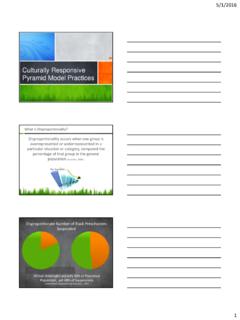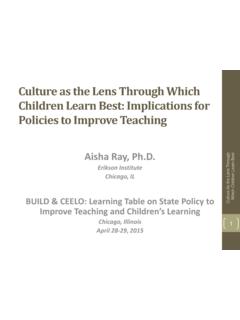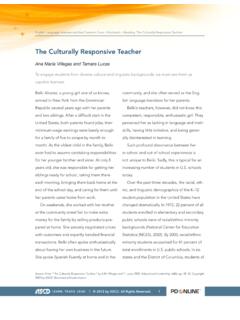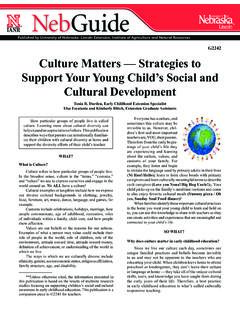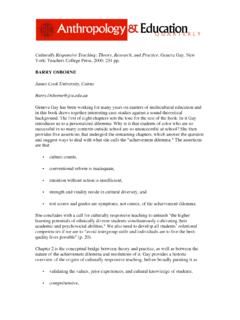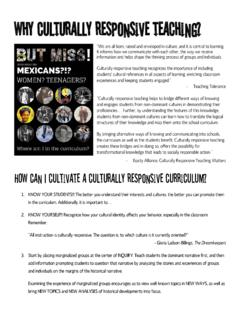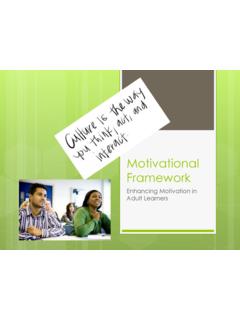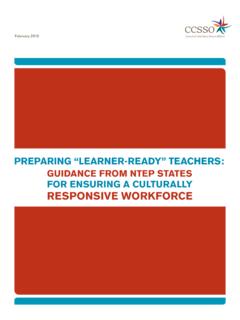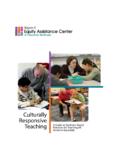Transcription of Professional Learning for Culturally Responsive Teaching
1 Equity In ActionEquity Matters: In Learning , for Learning forCulturally Responsive Teaching2 Communities Flourish When Equity MattersEquity Matters: In Learning , for Life. Education expands our understanding of ourselves, the worlds in which we live, and the possibilities of what we can be-come. Students have a right to high-quality Learning opportunities in which their cultures, language, and experiences are valued and used to guide their Learning . Equity is measured by the degree to which people belong, feel included, and are empowered. Universal equity cannot be achieved without creating systems that embody the principles of everyday Matters: In Learning , for Life Learning forCulturally Responsive TeachingKathleen A.
2 KingAlfredo J. ArtilesElizabeth B. KozleskiArizona State UniversityEquity In ActionJune, 2009 OESEOffi ce of Elementary andSecondary Education4 Professional Learning For Culturally Responsive Teaching At a time in the United States when schools across the country have labored to improve results for All students as a result of massive policy changes, several key outcomes remain intractable. Two outcomes, in par-ticular, remain troubling; achievement gaps across ethnic groups of students persist, and subgroups of students from Culturally and linguistically diverse (CLD) backgrounds continue to be identifi ed and placed in special educa-tion at disproportionate rates (Artiles & Bal, 2008; Teese et al., 2007).
3 Ac-cording to the most recent analysis of national data, the risk for dispropor-tionality for African American students in some states is as high as 4 times as likely as for all other students in the category of emotional disturbance and as low as 25 percent as likely in other states (Sullivan & Kozleski, 2008). As special education reform efforts shift to focus on early intervening in general education classrooms, an important aspect of redressing disproportionality remains teachers access to resources and Professional Learning opportu-nities that can help them redesign Learning environments to address the educational needs of their increasingly diverse students. This approach is called Culturally re-sponsive Teaching , which is defi ned by Ladson-Billings (1995a) as possessing these eight principles: Communication of High Expectations Active Teaching Methods Teacher as Facilitator Inclusion of Students who are Culturally and Linguis-tically Diverse Cultural Sensitivity Reshaping the Curriculum Student-Controlled Classroom Discourse Small Group Instruction and Academically-Related DiscourseIn a National Academy of Sciences commissioned review of Learning theory and research, Bransford, Brown, and Cocking (2000) located this model in the so-called student-centered ap-proaches.
4 Developing a knowledge base that is grounded in the notions of Culturally Responsive Teaching is an im-portant leap forward in understanding the gap between students experiences and histories and teachers knowledge and expectations about what schools and classrooms are supposed to look like. However, as the Report of the AERA Panel on Research in Teacher Education (Cochran-Smith & Zeichner, 2005) suggests, the preparation of new teachers is only recently addressing the link between culture and Learning in substantive ways. This means that the current Teaching force has had little formal preparation in conceptualizing and framing practice as cultural work and/or through a cultural prism. Profes-sional Learning must therefore assume an important role in engaging practicing teachers in examining and transforming their own practice in ways that ac-knowledge the critical role that culture and language play in is much to celebrate about the increasingly sophisticated understand-ing of the role of Professional Learning in the Teaching profession.
5 Ongoing Professional Learning is more and more Professional Learning for Culturally Responsive Teaching has the potential to address achieve-ment gaps across ethnic groups and disproportionate representation in special education for students from Culturally and linguistically diverse backgrounds. This Equity In Action has a twofold purpose: (a) to demonstrate the need for rethinking current approaches to Professional learn-ing and (b) to provide guidelines for Professional Learning for Culturally Responsive Teaching , as well as research-supported examples of schools and districts engaged in this process. Equity Matters: In Learning , for Life in classrooms rather than in traditional Professional development workshops (Bransford et al.)
6 , 2000). This approach elevates the role of the teacher as learner and is infl uenc-ing the ways in which states, school districts, and local public schools are making time for ongoing Professional Learning among teachers. However, much Professional Learning research and practice still omits discus-sion about cultural considerations. At times, the need for understanding the cultural nature of Teaching and learn-ing is noted without in-depth analysis about how culture mediates student and teacher classroom interactions and Learning processes. This practitioner brief is designed to explore a missing dimension of Professional Learning : Culturally Responsive Teaching . Professional Learning for Culturally Responsive Teaching is grounded in research on teacher Learning that is mindful of the role culture plays in the knowledge that educators bring to their practice, as well as how educa-tors learn and make sense of their daily practice.
7 It also emphasizes how educators biographies, Professional identities, and awareness of the techni-cal ( , how-to), contextual ( , how circumstances shape the ways things are), and critical ( , the social justice lens) aspects of education impact their Professional practice. We begin this piece on Equity In Action by highlighting a set of principles to guide Professional Learning experi-ences that foster Culturally Responsive Teaching . Next, we identify four key arenas that have been at the forefront of teacher Learning research in the last 10 years. Finally, we provide exemplars of Professional Learning efforts for cul-turally Responsive Teaching from each research arena, that are grounded in the Professional Learning principles, and which demonstrate Professional Learning opportunities that prepare teachers to work for equity, participa-tion, and access for All Principles Of Professional Learning To Prepare Culturally Responsive TeachersProfessional Learning principles emerged from a variety of research traditions, particularly those focused on sociocultural perspectives, which explore the relationship between individual psychological characteristics and a practice based model of human development and Learning (Artiles, 1996.)
8 Rogoff, 1990, 2003). This theory of human development enables us to understand the ways in which children s and adults participation in everyday (cultural) practices whether they take place in classrooms, homes, or playgrounds shape their develop-ment and Learning . This model also requires that we focus on the meaning and purpose of the activities in which people participate. Sometimes the meanings and purpos-es of activities are defi ned by a com-munity s traditions, but event interpreta-tions and goals are often negotiated in situ. Further, learners ( , students, teachers) use cognitive, social, and affective resources appropriated in their own communities to participate in formal and informal Learning environ-ments.
9 However, learners performance in everyday activities is not solely shaped by their own developmental character-istics. Performance is also mediated by the nature of events ( , linguistic and cognitive demands, etc.) and the institutional conditions in which events take place ( , rules, assigned roles, expectations) (Gallego et al., 2001). Professional Learning that is informed by these key assumptions can better prepare teachers to practice Culturally Responsive Teaching . As we explain in this brief, this kind of Professional Learning provides teachers with op-portunities for and guidance in the examination of how their own beliefs and knowledge about Teaching are mediated by their educational experi-ences and sociocultural backgrounds as well as institutional and situational demands of their work.
10 Knowledge about Teaching must be more than a deep understanding of subject matter. Although content knowledge is an im-portant element related to Professional Learning , Culturally Responsive practice infuses content with an understanding of the cultural nature of Learning . Understanding the need to explore personal and Professional identities as well as the necessity of responding to the strengths and needs that students from all cultural backgrounds bring to classrooms, The Equity Alliance at ASU has generated a set of principles to guide Culturally Responsive profes-sional Learning . The principles were infl uenced by research from the Center for Research on Education, Diversity, and Excellence (CREDE), the research of McLaughlin and Talbert (2006) with teacher Learning communities around the nation, and the work of the National Staff Development Council.
